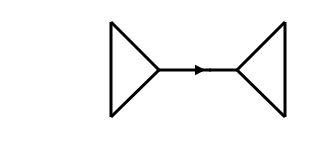Start with some standard stuff. Suppose we have a directed graph $\Gamma$. I'll write $e : v \to w \,$ when $e$ is an edge going from the vertex $v$ to the vertex $w$. We get a vector space of 0-chains $C_0(\Gamma,\mathbb{R})$, which are formal linear combinations of vertices, and a vector space of 1-chains $C_1(\Gamma,\mathbb{R})$, which are formal linear combinations of edges. We get a boundary operator
$$ \partial : C_1(\Gamma,\mathbb{Z}) \to C_0(\Gamma,\mathbb{Z}) $$
sending each edge $e: v \to w$ to the difference $w - v$. A 1-cycle is a 1-chain $c$ with $\partial c = 0$. There is an inner product on 1-chains for which the edges form an orthonormal basis.
Any path in the graph gives a 1-chain. When is this 1-chain orthogonal to all 1-cycles?
To make this interesting, I need to rule out some obvious possibilities. If we have a graph consisting of two triangles connected by an edge, the path consisting of that one edge will be orthogonal to all 1-cycles:
To rule out this sort of situation, let's suppose $\Gamma$ has no bridges, meaning edges whose removal increases the number of connected components. The edge with the arrow on it in the picture above is a bridge.
Question: Suppose $\Gamma$ is a graph with no bridges. Any path in such an embedded graph gives a 1-chain. If this 1-chain is orthogonal to all 1-cycles, must it vanish?
To make this precise: I'm defining a path $\gamma$ to be a finite sequence of edges $e : v \to w$ and their formal 'inverses' $e^{-1}: w \to v$, like this:
$$ e_1^{\pm} : v_0 \to v_1, $$ $$ e_2^{\pm} : v_1 \to v_2 , $$ $$ \dots $$ $$ e_n^{\pm} : v_{n-1} \to v_n .$$
The corresponding chain is
$$ c(\gamma) = \pm e_1 \pm e_2 \pm \; \cdots \;\pm e_m. $$
Question: If $\Gamma$ is a graph with no bridges, and $\gamma$ is a path in $\Gamma$ such that the inner product of $c(\gamma)$ with every cycle vanishes, must we have $c(\gamma) = 0$?
I believe someone should have settled this by now, since it sounds easy, and the space of 1-chains orthogonal to all cycles has been studied quite a lot: it's called the cut space of the graph.
A cut is a partition of the vertices of a graph into two disjoint subsets. Any cut determines a cut-set, the set of edges that have one endpoint in each subset of the partition. If we take the sum of all those edges, we get a 1-chain orthogonal to all cycles. It's known that the cut space is spanned by 1-chains coming from cuts in this way. For example, in the graph I drew, the edge with the arrow on it spans the cut space.
A proof can be found here:
- Norman Biggs, Algebraic Graph Theory.
but I suspect there's a lot more known about this subject!
[Note: I have edited my original question to simplify the hypotheses, and also called elements of $Z_1(\Gamma,\mathbb{R})$ 1-cycles, to distinguish them from cycles in the sense of graph theory.]

